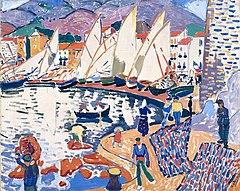Giacobbe Giusti, André DERAIN: Le séchage des voiles (The Drying Sails), Pushkin Museum, Moscow

André Derain(French: [dəʁɛ̃]; 10 June 1880 – 8 September 1954) was a French artist, painter, sculptor and co-founder of Fauvism with Henri Matisse.[1]
Biography
Early years
Derain was born in 1880 in Chatou, Yvelines, Île-de-France, just outside Paris. In 1895 Derain began to study on his own, contrary to claims that meeting Vlaminck or Matisse began his efforts to paint, and occasionally went to the countryside with an old friend of Cézanne‘s, Father Jacomin along with his two sons.[2] In 1898, while studying to be an engineer at the Académie Camillo,[3] he attended painting classes under Eugène Carrière, and there met Matisse. In 1900, he met and shared a studio with Maurice de Vlaminck and together they began to paint scenes in the neighbourhood, but this was interrupted by military service at Commercy from September 1901 to 1904.[4] Following his release from service, Matisse persuaded Derain’s parents to allow him to abandon his engineering career and devote himself solely to painting; subsequently Derain attended the Académie Julian.[5]
Fauvism

André Derain, 1905, Le séchage des voiles (The Drying Sails), oil on canvas, 82 x 101 cm, Pushkin Museum, Moscow. Exhibited at the 1905 Salon d’Automne
Derain and Matisse worked together through the summer of 1905 in the Mediterranean village of Collioure and later that year displayed their highly innovative paintings at the Salon d’Automne. The vivid, unnatural colors led the critic Louis Vauxcellesto derisively dub their works as les Fauves, or “the wild beasts”, marking the start of the Fauvistmovement. In March 1906, the noted art dealer Ambroise Vollard sent Derain to London to produce a series of paintings with the city as subject. In 30 paintings (29 of which are still extant), Derain presented a portrait of London that was radically different from anything done by previous painters of the city such as Whistler or Monet. With bold colors and compositions, Derain painted multiple pictures of the Thames and Tower Bridge. These London paintings remain among his most popular work. Art critic T.G Rosenthal: “Not since Monet has anyone made London seem so fresh and yet remain quintessentially English. Some of his views of the Thames use the Pointillist technique of multiple dots, although by this time, because the dots have become much larger, it is rather more simply the separation of colours called Divisionism and it is peculiarly effective in conveying the fragmentation of colour in moving water in sunlight.”[6]
References
- ^ Sabine, Rewald. “Fauvism”. from Timeline of Art History. New York: The Metropolitan Museum of Art, 2000–. Archived from the original on 14 December 2007. Retrieved 2007-12-17.
- ^ Diehl 1977, p.8
- ^ Cowling and Mundy 1990, p.92
- ^ Diehl 1977 p.14
- ^ “International Painting and Sculpture – Le Cavalier au cheval blanc”. National Gallery of Australia. Retrieved 2007-12-17.
- ^ Tom Rosenthal, reviewing Derain’s London paintings on show at the Courtauld Gallery, The Independent 4 December 2005
- ^ Jump up to:a b Clement 1994, p. 396
- ^ Jump up to:a b “Works on View: André Derain”. Guggenheim Hermitage Museum. Archived from the original on 25 January 2008. Retrieved 2007-12-18.
- ^ “Stein, The Autobiography of Alice B. Toklas“.
- ^ Hamilton 1993, p.207
- ^ Sotriffer 1972, p.59
- ^ Cowling and Mundy 1990, pp. 92–93
- ^ “Australia Dancing leaps into Trove”. Archived from the originalon 2011-08-08.
- ^ Dorléac, Laurence Bertrand (2008). Art of the Defeat: France 1940-1944. Los Angeles: Getty Research Institute. pp. 83–87. ISBN 978-0-89236-891-4. Retrieved 14 February 2012.
- ^ “André Derain Biography”. Namen der Kunst. Art Directory GmbH. Retrieved 2008-01-03.
- ^ Brettell, Richard R., Paul Hayes Tucker, and Natalie Henderson Lee (2009). The Robert Lehman Collection. III, III. New York, N.Y.: Metropolitan Museum of Art in association with Princeton University Press. p. 253. ISBN 9781588393494.
Further reading
- Clement, Russell (1994). Les Fauves: A Sourcebook. Greenwood Press. ISBN 0-313-28333-8.
- Cowling, Elizabeth; Mundy, Jennifer (1990). On Classic Ground: Picasso, Léger, de Chirico and the New Classicism 1910–1930. London: Tate Gallery. ISBN 1-85437-043-X
- Diehl, Gaston (1977). Derain. Crown Publishers, Inc. ISBN 0517037203.
- Hamilton, George Heard (1993). Painting and Sculpture in Europe, 1880–1940. Yale University Press. ISBN 0300056494.
- Sotriffer, Kristian (1972). Expressionism and Fauvism. McGraw-Hill. OCLC 1149407.